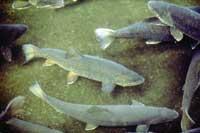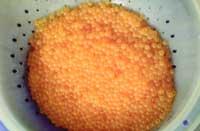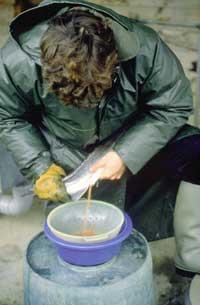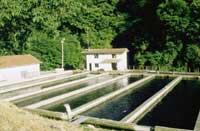In today's menu genetically modified salmon
In recent times there is a lot of talk about genetics, and since ethical problems are too difficult, put in the lab and ears deaf to world protests, geneticists are working seriously. So far his field of work has been limited to plants, but those ambitious people have not been able to be and have started working with animals. By next year there may be genetically modified salmon that grows six times faster. What will be its consequences? First, the warming of the pockets of salmon breeders and, second, although for the moment there is no total certainty, the mistrusts refer to the imbalances in the health and nature of the consumer.

The conclusion is that the work done so far does not seem to go back. The Canadian U.S. company AquaBounty Farm is waiting for the authorization of the U.S. Food and Drug Agency, and if all goes well, next year it will reach the Canadian and U.S. dish, and later the Asian one. The president of the company A/F Protein hopes to convince Europeans that genetically modified products give more reticence to Europeans.
History of genetically modified salmon
The history of fast growing salmon begins in 1986. Biologists Choy Hew and Garth Fletcher from Newfoundland Memorial University began to create a salmon capable of withstanding great cold. To do this, they took the ‘ice gene’ of a kind of limanda that lives at low temperatures and introduced it into salmon. If this were achieved, the residence of salmon king of salmonids would extend to the shores of northern Canada. But things didn't go as well as expected and the new salmon showed no resistance to cold.

But the work of the geneticists was not useless. In fact, they realized that the new gene stimulated the activity of the gene that synthesizes the growth hormone. He knows whether it was chance or not, but that at least the joy of geneticists and entrepreneurs was unquestionable. Thus was born in 1991 the new favorite salmon of fish breeders.
It was a job that cost millions of eggs and 10 million dollars, but according to biologist Arnold Sutterlin it was worth it. "Achievement has been greater than expected. We thought we would get salmon with 30% growth improvement, but we have increased by 400-600%." This salmon gets its commercial size in 14 months, 22 months before natural salmon. From this size, biologists who have been working insist that genetically modified salmon grow no more than natural salmon.
Now, in order to market it, industrialists must demonstrate that it has no harmful effects on human health, that is, it has no allergens or toxins. The amounts of vitamins, minerals, proteins and lipids of natural salmon should be similar and show that there are no accumulations of fat, tumors, skeleton deformation. But it can be thought that all the tests are overcome, since the salmon nurseries have bought 15 million eggs.
Do salmon boxes know safety measures?

The species transported by man from one side to the other in the world have been numerous and most of them have had negative consequences in their new home. For example, in the 1960s, the entry of the common perch of the Nil River into Africa's Victoria Lagoon has been enough for a decade to go from 80% to 2% of the stock of about 400 smaller species than the perch. All odds point to the disappearance of 50% of native species, since they were unable to escape the clutches of the new predator.
On this occasion, instead of moving the species from one habitat to another, they have created it. Sure, the goal is not to leave it freely in nature, but who can believe that it will not escape genetically modified salmon from the cultivation boxes?
Companies involved in the research of genetically modified salmon consider banal the possibilities of abandonment of salmon. They say salmon would grow in the nurseries of the earth (although most nurseries are at sea). In addition, there is no reason for fear, since all salmon from the sea farms would be sterile. In this way, in case of leakage, they would not be able to reproduce with natural salmon. The beautiful words and words that have been said undoubtedly reflect security, but ecologists are not faithful and they seem to have no lack of reasons.
Distrustful ecologists
In fact, there have already been widespread rumors in which there have been uncontrolled escapades in experienced nurseries. There is still no total security, but ecologists say that crops do not guarantee 100% safety. In addition, this grid is reinforced by some events that occur with genetically modified plants. For example, in 1997 Monsanto sold in Canada a genetically modified rapeseed not allowed to sow 300 hectares.

In 1998 it was discovered with the sugar beterrab and in the sugar refinery the genetically modified sugar beterraba was mixed with normal sugar. Leakage by poor safety measures or failure in the fish factor can have serious consequences. In fact, rapid growth, for the first phases of salmon life, requires great food needs that can generate imbalances in ecosystems.
On the other hand, although biologists have not yet created a salmon that adapts to the low temperatures, there are great interests for it and the risk would extend to the new ecosystems.
As for sterilization, today there is no technique that sterilizes 100% of the fish, and 99% of the fish is not enough to be sterile, since genetically modified salmon grow faster and are more attractive for reproduction.
Researchers at Purdue University have found that a few fish that grow faster to undo a large population are sufficient. Genetically modified fish transmit this gene change to the second generation, but the survival of the second generation decreases considerably, thus putting salmon on extinction tracks over time. The gene change is known as the “Trojan gene”, attractive but which would ultimately harm the reproductive species.
Fish genetically modified against hungerFaced with the controversy provoked by the fish, they have launched a new argument. Genetically modified fish have not been elaborated by large aquaculture companies to obtain greater benefits, but to end hunger in the world. Elliot Entis, president of A/F Protein, said: "Fast growing salmon will allow for intensive growth, a reduction in production costs and, therefore, a reduction in the price of fish". Often chollo for those big entrepreneurs! Oh, sorry!, for Africans who are starving! But, since when do African temperate waters like salmon? Calm, they also think about it, and temperate water fish are in the process of genetic transformation. In addition, new ideas have emerged and now they want to create fish that digest legumes rich in proteins. Genetics is an intelligent mother! |
Published in the supplement Natura de Gara
Buletina
Bidali zure helbide elektronikoa eta jaso asteroko buletina zure sarrera-ontzian











